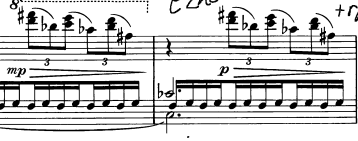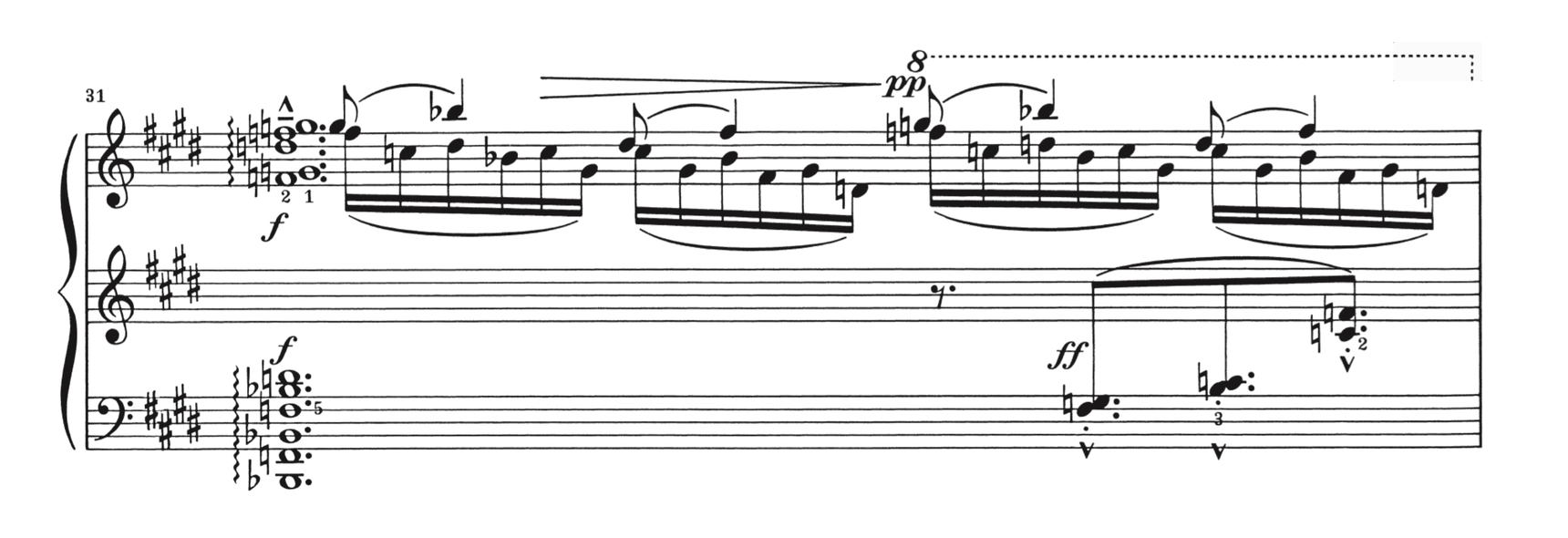Week 3 Goal – Reflect on Your Journey So Far!
Week 3 Goal – Reflect on Your Journey So Far!
This week, the plan is that you’ve gotten through your Debussy piece at least once. Take a step back and reflect on your experience:
What surprised you most as you learned this work?
What part do you find the most interesting or beautiful?
What is the most challenging section for you right now?
💡 Bonus Challenge: Record a short clip of the section you find most surprising, interesting, or challenging, and share it with the group! Hearing different perspectives will inspire all of us.
23 replies
-
What surprised me the most about Arabesque. No. 1 is how simple it sounds, yet how tricky it is to play. I think with much of Debussy, a novice can just hold the pedal down and let the sounds merge and it will still sound lovely. But to play this piece correctly, and to carry the mood of lightness and grace, one needs to be careful of the musical lines, the pedaling, and of course, the 2-against-3 rhythms.
The part I find the most interesting - not necessarily the most beautiful (if fact, it stands in contrast to the beautiful, sinewy melodic lines throughout most of the piece) - are the Schubertian chords in measures 64-66* (marked "Risoluto"). The word 'resolute' in English means steady or unwavering. Compare this section to the "wavering" lines in the rest of the piece. There can be many thoughts as to why Debussy puts this passage just before the final return to the original theme. Perhaps it's to temporarily ground us before repeating the dreamlike melodies again. I'm not sure, but this sort of "chordal resting place" happens in another piece I'm working on, Brahms' Intermezzo Op. 118 No.2, in the section marked "piu lento."
*I've attached a recording of these few chordal measures
For me, the most challenging section is measures 24-26 where the right hand plays an ascending line. I find it difficult to create a sense of crescendo and to bring out the top voice (pinky) while playing the lower notes at a softer volume. I was fortunate to have worked on this section with Bob Dorso and Dominic during the Tonebase Piano Camp last week and they had great suggestions for me. Perhaps I'll record this section at a later date.
-
Hi everyone, just an update on this piece with a recording of progress to date. I think the special part of this piece is the middle section which manages to make time stand still in a tranquil space despite being surrounded by very energetic "technical" passages. It's a perfect blend of motion and reflection. Derek
-
The Little Shepherd
The part I find most beautiful, challenging and surprising is the dance (or response) element of the third flute/dance (or call/response ) section. Here, the rhythm of the dance which so far has been dotted 16th+32nd up/down, up/down, with the final descending triplets providing a resolution, becomes a polyrhythm (3 over 2) that goes up 3 times and then down. I find the polyrhythm of this ascending line challenging and the line itself with the ascent and the harmonies, to be quite beautiful and mystical. It suggests a breaking through somehow - going beyond or through the confines of the world we know, where the light has changed from a pale gold to a pure white that washes over one.
What is surprising is the very sophisticated nature of the experience created by this musical concept when juxtaposed with the stated intent of the composition, i.e. infusing his daughter’s toys and playtime with joy.
Here is the snippet (as best I could).
-
In Clair de Lune, I find the most beautiful part to be the recap of the first theme with different harmonies. It’s unexpected, and as this piece is heard so often as background music, particularly the beginning, it’s nice to enjoy a less familiar part of it. I like the airy, floaty feel it creates.
https://youtu.be/36ROrz2kmZI?si=syuQfk7BtHuBpWyw -




Pour le piano - Prelude (annotated score attached...work in progress)
1. I was surprised at how many diminished and augmented chords are in the piece. They are partly responsible for the piece's unsettled vibe.
2. Most beautiful is the end, really, after the cadenza, where the melody in the right hand comes in. Lovely and dignified. (and then the next whooshy section is weird, haha.)
3. Most challenging sections are in the attached photos. the 3/4 at speed is tricky, and the left hand trill while holding down the pinky isn't easy for me. For the second pic, the left and right hands are playing with thumbs overlapping (they're both treble clef), and it's supposed to be pretty fast. My hands get tied up and my left hand doesn't want to keep up. For third and fourth pictures, the left hand does some jumping, and the bass needs to stand out as a descending melody without breaking the momentum of the music, which is also difficult for me. Any tips would be appreciated!
I may be able to upload a "progress report" video tomorrow...we'll see!
-
Et la lune descend sur le temple qui fut
The biggest surprise was how frequently Debussy relies on parallel motion, especially in octaves. Instead of conventional voice-leading, he builds entire passages out of these moving blocks, which creates a sense of ritual chanting and removes the expectation of harmonic progression. It’s striking how effective this is at suspending time.
Bars 25–30 stand out as the most beautiful: the plain-chant melody floats with a transparent, almost weightless accompaniment. The gentle descending triplets dissolve into the chant, which then settles into the so-called “Buddha motive”. This passage feels like the core of the work’s spiritual atmosphere.
Bars 14–15 are the trickiest: the grace notes in the right hand must decorate the left-hand melody, while at the same time fitting into a 3-against-2 rhythm. The challenge is not just technical but also expressive — the ornamentation must remain supple and natural without disturbing the calm pulse.
-
So I better start off by saying something about the piece, La puerta del vino as last week’s assignment. The gate is art of the Alhambra Palace in Granada Spain. A really beautiful place with beautiful gardens and buildings. I’ve read that this piece paints the picture of the market that took place around this gate. There are Spanish influences to be heard in the Habanera rhythm that underpins the piece and the flamenco rhythms in the mixing of triplets and duplets. Dynamically there is a mixture of extreme louds and softs, some quite unexpected.
As for difficult sections there are about 8 bars just after half way which are a storm of accidentals and quite dazzling but, if you look closely you’ll see the chords are triads and actually quite friendly. How friendly you’ll find out at the online performance on September 3rd!
-
And here’s my progress so far. Today was a busy no-practice sort of day, and this video was a single take of me playing cold with kids milling about after dinner. There are some hesitations, memory slips, and other issues, but it’s starting to take shape I think.
(I mostly learned the piece and then put it down for some 15 years…figured this challenge would be a good time for me to bring it back to life.)
EDIT: FINAL VERSION (for now) HERE: https://www.youtube.com/watch?v=zMNcMsnPZxM
https://youtu.be/ebI4aoL7eNo -
Ballade no 70
the most surprising thing I learned from this work is Polyrhythm specially, triplets or 5 or 6 16 th notes vs triplets or 8ths on RH. Also a sense of rubato, agogic expression, tempo changes( such as poco mosso, animez peu a peu, Morendo, tres retenu, rit, a tempo).
The most interesting and beautiful part are the expressive melody lines, mood changes, complexity of voicing and harmonies.
the most challenging section right now is mm 63-66 polyrhythm; more LH practice to feel free to play RH and to be able play legato ( my hands aren’t big enough to play some sections) and choose the tempos. Shifting hands ex.mm 27–30 and more (🧐) -
What surprised me the most as I (re)learned this work?
I've started to learn Ondine last summer, as it was to be part of a concert program at the local music school, where I take lessons, in November 2024. Ondine is based on illustrations by Arthur Rackham for the book Undine by F. H. C. de La Motte Fouqué, published in 1909. When preparing for the concert, I had a close look at these illustrations (you can easily find them online). When now relearning this piece, I was very surprised how these illustrations and the interpretation of the story that I had created for myself when learning Ondine, were present from the very beginning. That is on the one side very helpful, on the other side, it makes me impatient in regard to technical challenges.
What part do you find the most interesting or beautiful?
As this prelude tells a story, I find the whole piece interesting. Debussy is really a painter for me. When playing the notes, it feels like you're part of creating the scenery / the picture.
What is the most challenging section for me right now?
For me it is very challenging to be patient with the relearning process and to give careful attention to the technical challenges of this prelude, the voicing, phrasing, dynamics, the quick changes in character of the piece. As I was on holiday till August 24, I do not have much time to prepare it.
-
What has surprised me most as I am learning “Cloches à travers les feuilles” is how much variability of color and texture there is in a piece that I always remembered as very beautiful, but rather monochromatic. The middle section, with its cascading double notes in the right hand, the deep bell strikes in the low bass, and the ascending chords in the middle register, is quite complex harmonically. That section (see below) is also the most difficult one to play, and I have not mastered it yet. However, I find the quiet, mysterious, darkly hushed murmurings of the beginning and the end the most beautiful parts of this “Image”.







